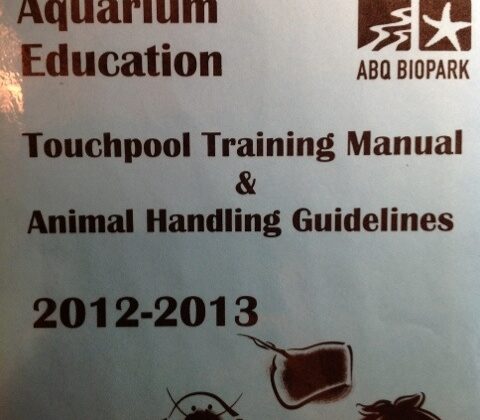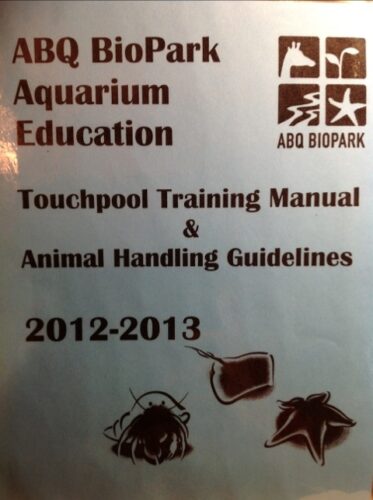
Most public aquariums have a volunteer program and I’m fortunate enough to live near a public aquarium in Albuquerque, NM. The Albuquerque Aquarium is just one feature of the family friendly ABQ BioPark which also includes the Albuquerque Zoo, Botanical Garden and Tingley Beach.
The Albuquerque BioPark Aquarium
Instead of trying to sum up the aquarium myself, here is a straight quote from the manual about the aquarium:
Located at 2601 Central Avenue NW, the aquarium exhibits Gulf of Mexico saltwater species from a variety of habitats, including surf zone, shallow waters, coral reefs, open ocean and deep ocean. The highlightof the aquarium is a 285,000 gallon shark tank with a 38-foot-wide, 9-foot-high, 8-inch thick acrylic viewing window. Jellies: Aliens from the Sea, featuring moon jellies and Atlantic sea nettles, and the Moray Eel Tunnel are very popular with aquarium visitors. Oddities of the Sea features lined seahorses, pipefishes, a frogfish and colorfully patterned reef fish. The Rio Grande at Central Bridge exhibit in the aquarium lobby offers visitors an opportunity to compare the kinds of fish that lived in the Albuquerque reach of the Rio GRande 100 years ago and those found today. Walking distance through the aquarium and garden is 1.25 miles. We recommend scheduling one-to-two hours for you visit.
How I found out about the aquarium’s volunteer program
One of my personal goals is to visit all of the public aquariums in the US. As I thought more about this quest I started to wonder how aquariums are managed. What does it take for a public aquarium to run? So, I started looking through the job listing for my local aquarium and that’s where I stumbled across their volunteer program. What better way to learn more about how aquariums work than to become a volunteer? I signed up immediately and last week I went to my first day of training to become a touch tank volunteer.
Training Day
Before you can become a volunteer at the aquarium you are required to go through a five hour training session, two — two hour shifts shadowing at each Touchpool with an experienced volunteer (8 hours total) and then you must pass a quiz on the Touchpool animal biology and natural history. I completed the initial training session last week. In the training session, each volunteer was given a booklet that contained facts about the animals we would be working with and guidelines for interacting with those animals.
During the training session the instructor gave us an overview of all of the animals we would we working with, went through the volunteer guidelines, and we ended the day getting a guided tour of the aquarium by an experienced Docent.
There are two different areas at the Albuquerque Aquarium where I will be volunteering: The Shark and Ray Encounter and the Invertebrate Touchpool.
The Shark and Ray Encounter
The Shark and Ray Encounter is located near the center of the aquarium. The exhibit contains small brown banded bamboo sharks, white-spotted bamboo sharks, southern sting rays, and Atlantic sting rays. As part of the training session we were given a guided tour of the entire aquarium and allowed to interact with the animals ourselves. There is only one right way for the guests to touch the animals and that is using two fingers while avoiding the head and tail of the animals.
There are a couple reasons that touching is limited to only two fingers. When a single finger is used, children tend to poke the animals instead of just making contact with them. Getting jabbed in the side is obviously stressful to the animals so telling children to use two fingers helps to get them in the right mindset for how to make contact with the animals. Likewise, using two fingers instead of the whole hand helps to prevent guests from attempting to grab or pinch the animals.
Invertebrate Touchpool
The Invertebrate Touchpool is a mobile aquarium and volunteers are free to choose the animals they wish to display in this exhibit. The invertebrates are kept in the same area as the quarantine tanks which are out of the view of the public. The quarantine area of the aquarium is where new, sick or stressed animals are kept where they are treated or acclimated before being placed into the publicly viewable aquariums. The invertebrates each have their own home where they are kept with compatible animals to prevent any late night snacking by would be predators.
The animals are treated will and limits are set as to how often and how long they can be displayed in a touch tank. No animal is to be displayed for longer than one hour and some animals are only allowed to be displayed once a day. The animals include horseshoe crabs, calico crabs, spider crabs, hermit crabs, helmet conch, milk conch, murex, whelk, anemone (which is only for display… no contact is allowed), and sea urchins. In animal that appears to be injured or distressed must immediately be removed from the touch display and one of the aquarists will be contacted to review the animal’s health.
What happens next
My next step is to sign up for my shadowing shifts. As I mentioned above, I have to work with an experienced volunteer for two – two hour shifts for both of the exhibits. I will be working the invertebrate touchpool first and it just so happens that my first shift lands on Earth Day. The aquarium is holding a big Earth Day event so it’s going to be a busy day.
Get Involved
If you live near a public aquarium and want to volunteer, check their website to see if they have a volunteer program. It is a great way to learn more and to become a better aquarist. If you are in Albuquerque, stop by the touchpool and say Hi. Just don’t ask me any hard questions yet. I’m still learning. ;)








